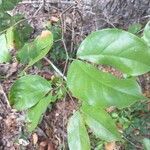Trees, 6-24 m tall. Branchlets grayish white. Petiolules ca. 3 mm; leaflets ovate-oblong, asymmetric, 5-8(-12) × 2.5-5 cm, both surfaces glabrous, base obliquely rounded, apex acute. Inflorescences panicles; bracts and bracteoles deciduous, ovate or orbicular. Flowers small. Calyx tube expanded and turbinate in upper part; lobes 7-11 mm, outside densely adpressed puberulent, inside densely white silky. Petals unequal in size, uppermost inner 3 larger, suborbicular, clawed, other 2 small, scaly, or sometimes 5 subequal and all clawed. Ovary shortly stalked, densely strigose at base. Legume blackish brown, slightly compressed, obovoid, 3-4.2 cm, tuberculate. Fl. Sep-Nov, fr. next May-Jun.
Leaves unijugate; stipules tiny, triangular with ciliate margins, early caducous; petiole 1.2–3 cm long, glabrous; leaflets 5.3–10.5 × 2.8–5.5 cm, ovate-elliptic, asymmetric, the inner margin weakly curved, cuneate at the base, the outer strongly curved and cuneate to subcordate at the base, apex bluntly acuminate, glabrous; midrib distinct, venation prominulous on both surfaces, resin vesicles (dark spots) scattered in the areolae beneath.
A tree. It grows 20-40 m tall. The leaves are alternate and the leaflets are unequal. The flowers are in a panicle. They are small and white. The fruit is a pod. It is reddish brown. There are 1-3 seeds.
Inflorescences axillary and terminal, paniculate; axis terete, densely to sparsely appressed-pubescent, glabrescent; bracts and bracteoles c.2.5 mm in diameter, subcircular, concave, very early caducous.
Pod c.5 × 3 cm, ovoid to ellipsoidal, glabrous except for a ring of hairs at the extreme base, with numerous superficial resin-filled vesicles, 1–3-seeded, indehiscent.
Ovary 4-ovulate, oblong, c.3 × 2 mm, pilose; stipe very short, densely spreading-hairy at the apex, glabrous below; style c.6 mm long, glabrous, stigma capitate.
Petals 5; the three upper ones white, clawed, the limb c.9 × 8 mm, suborbicular, the claw c.10 mm long; the two lower ones minute, c.1.5 mm long, oblong.
Calyx lobes 4, c.10 × 5–7 mm, broadly elliptic to obovate, densely pubescent outside, densely sericeous inside.
Seed dark brown, shiny, c.20 × 12 mm, ellipsoidal, enclosed in the cream-coloured mealy endocarp.
Large tree (or occasionally a shrub) to at least 20 m, with broad crown.
Stamens 10; filaments 12–14 mm long, glabrous; anthers dorsifixed.
Young branchlets pale brown, lenticellate, glabrous.
Flowers c.15 mm long; pedicels 5–7 mm long, terete.

